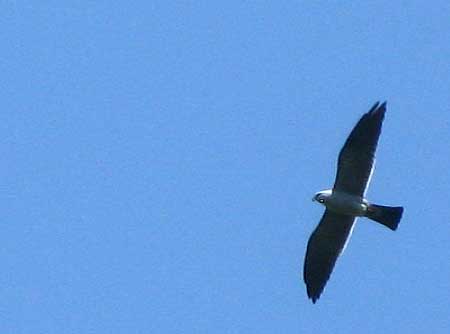Excerpts from Jim Conrad's
Naturalist Newsletter
from the May 20, 2012 Newsletter issued from the woods of the Loess Hill Region a few miles east of Natchez, Mississippi, USA
MISSISSIPPI KITES
The bird predator most commonly heard calling above us is the Red-shouldered Hawk, but nearly every morning another species appears circling overhead, and sometimes is heard calling from the nearby forest, a pure, melancholy-sounding, two-syllable FEE-FEEEEEEEE. I recognize this call from my hermitting days near here, when a pair making the call nested in the big Pecan tree next to my trailer. It's the Mississippi Kite, ICTINIA MISSISSIPPIENSIS. You can see what one looks like circling overhead below:

Kites tend to have longer, narrower tails and wings than regular buteo hawks. At first glance a Mississippi Kite's silhouette is similar to that of the Northern Harrier, but the harrier's tail is a little rounded at the tip, while our kite's tail is squared. Also, the harrier is much larger, with a wingspread of 43 inches (1.1m) as opposed to the kite's 31 inches (80cm). Being so small, they eat dragonflies, cicadas, grasshoppers and other large flying insects, with the occasional small bird or mammal.
from the June 21, 2002 Newsletter issued from the woods of the Loess Hill Region a few miles south of Natchez, Mississippi; elevation ~200ft (~60m), ~N31.42°, ~W91.41°; USA
MISSISSIPPI KITES
On Tuesday afternoon while I worked at the computer I heard a big wind coming through the forest in advance of a storm. Here you can hear those winds long before they hit, sounding like a big waterfall. Quickly I turned off the computer to avoid voltage spikes from falling tree limbs hitting the wires, and stepped outside to enjoy the spectacle.
A Mississippi Kite, ICTINIA MISISIPPIENSIS, hovered directly above me facing into the wind and when the gusts began knocking him about and bending the biggest trees, he just drew in his wings, screamed louder, and I am sure that he was doing exactly as I was, just enjoying the storm. I must tell you my kite story.
Early this spring a pair of Mississippi Kites arrived from their wintering grounds in South America (as far south at Paraguay) and for several days hung around a big pecan tree just one tree away from my trailer. Then one bird disappeared from view, but ever since the remaining bird has come and gone on a daily basis, and during most of most days he or she can be spotted sailing in tight circles on thermals above our fields. My impression is that the pair nested in the big pecan, have produced at least one offspring that has been fledged, and somehow they have managed to pull the whole thing off without my being able to watch the details.
Kites are hawk-like birds. All birds are divided into about 36 bird "orders." There's the "duck order," the "penguin order," and the "hawk-and-falcon order," for instance, with kites being members of the latter. That order is divided into 3 families. One family is the falcons, another the ospreys, and the third, the really big one, holds the hawks, eagles and kites.
Kites are especially graceful on the wing. They hover while hunting and when prey is spotted instead of diving headfirst they descend feetfirst, seize their victim, then swoop skyward again. During a visit to Natchez last summer I saw about 8 Mississippi Kites sailing over the Mississippi River right in front of town. Kites in general seem rather social and unafraid of humans. In Europe two kite species are common fixtures above many fields. In downtown New Delhi, India, many hours I have watched kites sailing among tall buildings, their elegant flight contrasting poignantly with the state of affairs at street level.
Mississippi Kites are fairly small, only 12.5 inches long (32 cm), as opposed to, say, Turkey Vultures, which are exactly twice as long. Therefore kite food is small, mainly grasshoppers and dragonflies, plus a few mice, toads and small snakes. You can read more about this species at www.ronausting.com/mississi.htm
During recent months many times I've glimpsed a kite darting into the pecan tree's upper branches, yet always by the time I could change position in order to see where it went -- just seconds -- already it would be disappeared. With binoculars I have scanned the pecan tree again and again looking for the nest or its entrance but I have seen nothing. I am embarrassed and impressed that this pair has for an entire nesting season eluded me.
One dusk right as a violent storm was beginning to let up, while it still rained, the wind was gusty and lightening was striking nearby, I heard one of the kites calling with a very urgent tone in its voice. Then there was a different call, obviously also a kite, but higher pitched and sounding nervous. I rushed outside only to see the silhouettes of two kites merging with the forest's shadows. I think that this was the moment of nest-leaving for the young, and I am amazed that such an unlikely moment was chosen. Yet, if you're a kite wanting to hide your kid's nest-leaving, what better time?
What a secretive bird this kite is! How I admire its sharpness and wisdom!